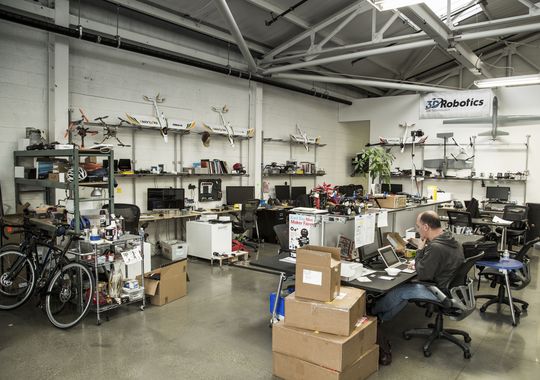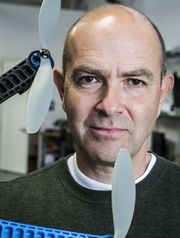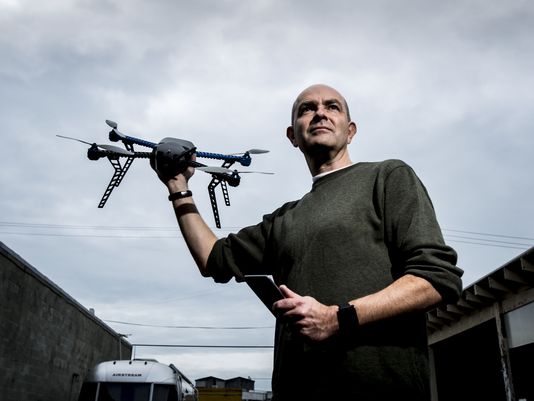Change Agents: Chris Anderson's drone dream takes flight
BERKELEY, Calif. — The flight plan of Chris Anderson's life is filled with funky layovers. Punk rocker. Physicist. Magazine editor. Book author. Geek dad.
But all those stops were just formative detours on the journey to his current role as CEO and co-founder of drone-maker 3D Robotics.
"I could argue that every step of my career makes sense, although from 50,000 feet it looks utterly random and insane," says Anderson, 52. "Even the punk rock phase makes perfect sense. Well, no, it doesn't make any sense at all."
Anderson laughs easily and readily, often at himself. Make no mistake, he's a voluble Renaissance man who's fully aware of his accomplishments as a particle physicist (at Los Alamos National Lab) turned magazine chief (with The Economist and then Wired, which he edited for the past 12 years).
But he'd rather talk about how he's the dumbest guy in the room at 3D Robotics, a mushrooming year-old garage-based operation that — thanks to some $37 million in venture capital infusions — is poised to be a leader in the coming drone economy.
"Being a journalist and being a CEO are similar, because as a journalist you're writing about the do-ers, and as a CEO you're empowering them and taking delight in their success," says Anderson. "I'm the worst programmer and electrical engineer here. And I should be."
3D Robotics' current show pony is called Iris ($750), an insect-like drone with four upturned propellers that can be rigged with a leveling arm for a GoPro camera. The rest of the company's wares include an array of electronic brains and physical parts that allow others to build drones to suit their particular needs. The bulk of its 190 employees work in engineering and manufacturing out of offices in San Diego and Tijuana, Mexico.

Chris Anderson, flying an Iris Multicopter.(Photo: Martin E. Klimek, USA TODAY)
It's worth pointing out here that while Anderson believes the skies soon will be buzzing with drones ("Sensors are everywhere except for the skies"), he doesn't envision or advocate for a future where unmanned autonomous vehicles — UAVs, in industry jargon — nip at us like mosquitoes as they track our every move.
"UAVs flying over your house is a safety issue. If someone's doing it, it's illegal, so we don't need a new law for that," he says, quickly adding that we're all being watched by everything from satellites to police helicopters. "We were paranoid about cameras and sites like Facebook, until we realized the pros outweigh the cons. We'll figure it out."
Anderson says the most obvious applications for drones are in the commercial space, ranging from entertainment (replacing pricey helicopters for those epic aerial shots) to agriculture (handling everything from crop monitoring to pesticide dispersion). "The market's booming," he says.
So much so that the Federal Aviation Administration will rule on drone regulations by the fall of 2015, when thousands of UAVs are expected to take flight.
Some will soar at airline altitudes, such as Titan Aerospace's Solara 60, a solar-powered drone designed to fly for five years while bringing Internet connectivity to the developing world. Facebook is said to be in acquisition talks with Titan.
"There will be restrictions on drones for safety and privacy reasons, but they're here to stay," says Daniel Burrus, a technology forecaster and founder of Burrus Research Associates in Milwaukee. "Agriculture makes a lot of sense for drones, but so do police and first-responder applications."
Burrus says that while UAVs may be hard to picture in busy cities, "75% of America is rural, and there are just fewer issues with this in less-populated areas. You could imagine national parks or ranchers using drones to check on herds."
If there's a man who can envision those and other innovative drone missions (overheard at 3D Robotics: talk of conservation groups using them to monitor endangered species), Anderson is that guy, says Jon Callaghan of San Francisco-based investment firm True Ventures.
"Chris consistently sees where the world is going and knows how to decode technology's effect on our lives," says Callaghan, whose decade-long friendship with Anderson translated into a majority investment stake in 3D Robotics.
"What always impressed me about him was his willingness to ask the world for help when he didn't know the answer himself," he says. "Innovators who tend to succeed are the ones who are most open and intellectually humble."
That's a specific reference to 3D Robotics' genesis story, retold in Anderson's 2012 book Makers: The New Industrial Revolution. The tale ranks up there with other tag-team tech miracles, include the Steve Jobs-Steve Wozniak Apple birth and the Bill Gates-Paul Allen Microsoft big bang.
It centers on a fateful weekend in 2007 when Anderson, eager for his five children to adore science, went home with a Lego Mindstorms NXT robot kit and a model airplane. The robot didn't do much, and the plane flew into a tree.
"The kids said, 'This sucks, and you suck,'" laughs Anderson.
Then the epiphany: The editor by day, inventor by night decided to tweak his Lego kit and build a crude autopilot for the model airplane. "I got chills when it worked," says Anderson, whose resulting creation is now in the Lego museum in Denmark. "When you do something that you really aren't supposed to be able to do, you know everything has changed."

An interior view of the 3D Robotics office in Berkeley, Calif.(Photo: Martin E. Klimek, USA TODAY)
Not long after, Anderson started a blog — DIY Drones — to help his nascent community of drone-makers help each other. One day an e-mail came in, loaded with inventive code, from a 20-year-old from Tijuana, Mexico, named Jordi Munoz.
"Suddenly, he was the smartest guy I knew," says Anderson, who seeded Munoz with funds to begin building drone circuit boards that his blog's readers were clamoring for. A few years passed, and the operation grew: "When Jordi came to me and said, 'We're going to do $5 million in sales this year,' I knew it was time."
In 2012, Anderson left Wired — the only editorial job he coveted from his lofty perch at The Economist, where he led Internet and business coverage in London, Hong Kong and New York — and took entrepreneurial flight.
If Anderson feels unusually comfortable at the helm of a business after decades in journalism, he has two specific experiences to thank.
One is spending summers in Los Angeles with his Swiss grandfather, Fred Hauser — who invented the automatic sprinkler — which was the result of being "a rotten teenager" to his parents in Washington, D.C. "When I started tinkering with drones 34 years later, I thought, 'Oh my God, I turned into my grandfather.' "
And the other is his years as a scowling bass player in a D.C. punk band called — wait for it — R.E.M. They changed their name after they agreed to a battle of the bands with a group from Athens, Ga., with the same name. Enough said.
"I would argue that the seeds of the Web started in the '80s punk rock movement," he says. "The notion that we could record, press and market our own music using four-track recorders, small plants and 'zines was a revelation. And today, tech-oriented kids have 3-D printers, Kickstarter campaigns and social media to get the word out. Many of us in that '80s punk rock scene felt we could go our own way."
If drones don't take off, be sure of one thing: Anderson will be back on his metaphorical runway, ready for a new idea to take wing.
——
ABOUT CHRIS ANDERSON, 52
What: CEO and Co-founder, 3D Robotics, which makes drones
Where: Berkeley, Calif.

Chris Anderson, 3D Robotics CEO.(Photo: Martin E. Klimek, USA TODAY)
Best advice you ever got? "It's cliché, but Nike was really on to something with 'Just Do It.' Also, 'Ask forgiveness, not permission.' And finally (open source software movement pioneer) Tim O'Reilly's advice, 'Create more value than you capture.'"
Why were you drawn to science as a kid? "I was inspired by (Enrico) Fermi and (Robert) Oppenheimer, who struck me as having the most fundamental understanding of world. As physicists like to say, the world is all physics and stamp collecting."
What's the biggest challenge of running a start-up? "Not the big stuff, like products and strategy, but rather making time for all the basic organizational foundations we take for granted in existing companies, from human resources to legal and financial systems. If you don't hire people who know and value those parts of the business at the start, you'll continue to run into problems as you grow."
USA TODAY's Change Agents series highlights innovators and entrepreneurs looking to change business and culture with their vision. E-mail Marco della Cava at This email address is being protected from spambots. You need JavaScript enabled to view it.. Follow him on Twitter: @marcodellacava.










